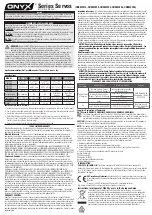
Diagnostics Optimization CT MODBUS RTU Technical Data
E300 Design Guide
151
Issue Number: 1
Table 7-2 Motor parameters
Should the motor rotate in the incorrect direction due to the system wiring
Reverse Motor Phase Sequence
(
B26
), this can be used to invert the
direction.
Table 7-3 Encoder parameters
Should the encoder increment in the wrong direction,
Drive Encoder Feedback Reverse
(
C12
) can be used to invert the direction of rotation. If there
is motor acoustic noise during operation following the autotune, refer to section 10.3
7.3 Autotune
Prior to an autotune being carried out, the motor nameplate data must be set-up and for RFC-A, RFC-S operation with a position feedback device the
position feedback parameters must be set-up. There are two possible autotunes available, these being a static autotune and a rotating autotune as
described here.
Both the static and rotating autotunes are available for Open loop or RFC-A, RFC-S operating modes. The static autotune will measure motor
parameters to provide good control, and the rotating autotune will measure motor parameters to provide a higher level of control. Only the rotating
autotune will check the position feedback device connected to the drive. Refer to
A26
(
Motor Autotune
B11
) used to select the required autotune,
None (0) Static (1) Rotating (2).
7.3.1 Static Autotune
A26
(
Motor Autotune
B11
) = Static autotune (1). The following describes how an autotune test can be initiated and normal operation resumed
following successful completion of the test:
The static autotune is carried out with the output motor contactors closed as the motor is energized, the motor brake remains fully closed during the
complete autotune test. The control over the output motor contactors and the brake during the static autotune must be made manually.
1. The static autotune test cannot be initiated if the drive is tripped
Drive OK
(
L05
) = Off (0) or the drive is active
L06
drive can be disabled by removing the drive enable signal from control terminal 31.
2. A static autotune test is initiated by setting
A26
(
Motor Autotune
B11
) to Static autotune (1)
3. The output motor contactors should be manually closed by an authorised person who is familiar with the requirements for safety, this sequence
also applies the drive enable signal on control terminal 31.
4. A drive run signal should be applied.
5. The static autotune will commence.
6. If the autotune sequence is completed successfully the drive enable is set to inactive (Inhibit) and
A26
(
Motor Autotune
B11
) is set to zero.
7. The output motor contactors can be opened.
8. The drive enable will only be set active again by firstly opening the output motor contactors and removing the drive enable.
9. If a trip occurs during the autotune sequence, the drive will go into the trip state and
A26
(
Motor Autotune
B11
) is set to zero. As above, the drive
enable must be removed and re-applied before the drive can be restarted after the trip has been reset.
Care should be taken if the autotune
was not completed as the drive parameters that should have been measured and set-up will still have their original values.
The following describes the effects of the autotune test on drive parameters:
1. The static autotune relies on the motor being stationary when the test is initiated to give accurate results.
2. Parameters associated with the motor and feedback (position feedback phase angle), are updated following successful completion of the
autotune test.
Parameter
Mode
Detail
Motor Rated Current
(
B02
)
Open loop, RFC-A, RFC-S
Motor nameplate data
Motor Rated Voltage
(
B03
)
Motor Rated Power Factor
(
B04
)
Open loop
Can be derived from rotating autotune
Motor Number Of Poles
(
B05
)
Open loop, RFC-A, RFC-S
Open loop and RFC-A mode select automatic if unknown
Motor Rated Frequency
(
B06
)
Motor nameplate data
Motor Rated Speed
(
B07
)
For Open loop, RFC-A control ensure correct slip speed
refer to parameter
A16
(
Slip Compensation Enable
B10
)
Symmetrical Current Limit
(
B16
)
Maximum operating current limit to protect motor.
Reverse Motor Phase Sequence
(
B26
)
Parameter to rotate motor output phase rotation.
Parameter
Mode
Detail
Drive Encoder Type
(
C01
)
RFC-A, RFC-S
Encoder nameplate
Drive Encoder Auto Configuration Select
(
C02
)
Can only be used with encoders with comms
Drive Encoder Rotary Pulses Per Revolution
(
C03
)
Encoder nameplate data / auto configuration
Drive Encoder Voltage Select
(
C04
)
Encoder nameplate data
Drive Encoder Feedback Reverse
(
C12
)
Parameter to rotate encoder feedback position
Setting the encoder power supply voltage too high for the encoder connected to the drive could result in damage to the feedback device. Only
increase the encoder power supply voltage setting for suitable encoders connected to the drive.
CAUTION
NOTE
Содержание 03200106
Страница 490: ...0479 0024 01 ...
















































